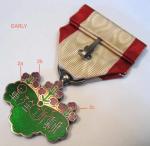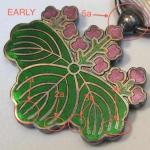-
Posts
1,751 -
Joined
-
Last visited
-
Days Won
3
Content Type
Profiles
Forums
Blogs
Gallery
Events
Store
Everything posted by Dieter3
-

Making sense of it all - Sacred Treasures of known award date....
Dieter3 replied to Paul L Murphy's topic in Japan
To Nick and Pieter1012 - Another bit of info that I think could be useful - the maker code on the top of the suspension knob. Is it possible to get a picture of this, or at least report the code???? -
AWESOME!!! Thanks so much for that, that is really great!!! I've gotta try and find some of the literature that highlights this info!! I really appreciate this.
-

Making sense of it all - Sacred Treasures of known award date....
Dieter3 replied to Paul L Murphy's topic in Japan
Nice! Would love to see it! Yes, these screws are consistent with later awards including current issue. Now we know they at least go back to 1983, quite helpful! -

Making sense of it all - Sacred Treasures of known award date....
Dieter3 replied to Paul L Murphy's topic in Japan
Absolutely agreed. Why I raise this question is simply because, while they are NOT in my possession, I have observed several pieces, that if you believe they really are correctly grouped and not thrown together by unscrupulous sellers (which is entirely possible), would refute this at least in part. These have all been Showa 18,19,20 year documents appearing with medals of a plain reverse construction, no rivets or screws. HOWEVER - just recently I saw an auction for a 1st or 2nd class (can't recall) and a document dated I believe Showa 60 - this piece had rivets which obviously supports what you say. This is what has me wondering if there was a possible mixture of medals, NIB items left over from before issue ceased that were kept and then subsequently issued starting in the 60s along with the "new" construction. There is NO question in my mind that rivet less , screwless construction was used in later years prior to the introduction of screws in late pieces - but the question is when exactly did this start? Indeed post-1967 as you suggest? Sometime during the war? It'd be nice to know for sure, though I don't know that without written evidence from authority or the Japan mint that we will ever know. All please note, I'm not saying anybody is right or wrong - I'm just trying to get to the bottom of things as I think we all are! -

Making sense of it all - Sacred Treasures of known award date....
Dieter3 replied to Paul L Murphy's topic in Japan
And here is one for thought - it can't be precisely dated (sorry Paul, I'm already going south!) - BUT - I think it is worth showing - it has some early features - love the pink bands!! But also, look carefully at the ribbon clasp - it has what appears to be a Sacred Treasure mirror on it. Most of the pieces of which I have photos are what I believe to be later pieces, and none exhibit this feature. Sorry the picture isn't the best! -

Making sense of it all - Sacred Treasures of known award date....
Dieter3 replied to Paul L Murphy's topic in Japan
See, now this is interesting. I've always been led to believe that the ones WITH rivets were WWII and prior, and that awards once re-issuance occurred were plain as were some late-war pieces, no rivets or screws! This one is obviously riveted. Either my belief is WRONG (at least partially), or there was a mixing of medal types. That medal also appears to have a hallmark - Paul, are you sure you're showing us the correct medal for this gentlemen? If it is correct, could it be one that was never awarded prior to the war's end, and safely survived only toy be awarded in 1967?? Scratching head.... -
Hi Paul, At some point, I shall! ;)
-
2a) Short horizontal bar 3a) Distinctly longer horizontal bar 2b) Taller character relative to its neighbor to the right 3b) Distinctly shorter!! 2c) Low angle on this "bar" 3c) Much greater angle http://gmic.co.uk/uploads/monthly_01_2012/post-6375-0-13386300-1326313406.jpghttp://gmic.co.uk/uploads/monthly_01_2012/post-6375-0-02360200-1326313420.jpg I think at least late Taisho and Showa era medals share these same "Post-War" features, or at least close. I have not applied any of this to 8th class at all. Very interested in comments!
-
If I may add a few of my own observations, I don't know that these can be absolute. These two examples are fair extremes - an early, no doubt (prob. mid-late Meiji, maybe early Taisho) and a Post-War, no doubt, 7th class. For those with lots of examples, please look at these notes and compare - can any of these points be used reliably? 1a) Notice - the veins have greater separation 2a) Notice - the veins are more pinched 2a) That's a long vein! 2b) That's a much shorter vein! 3a) A shallower indentation, and look where that vein tip is - not in the indentation 3b) A slightly larger indentation, vein tip is right in it! (Indentation is probably not a good word, but...) 4a) Look how close these vein tips are and where they are relative to the medal's edge 4b) Greater separation of the vein tips and different position relative to medal's edge 5a) Less rounded suspension ball 5b) More distinct rounding to ball Really, I'm not sure if this is a useful feature or not, the ball thing.
-
Hey, where's the picture!!?? :o
-

Applying the Golden Kite dating classification - a question for JapanX
Dieter3 replied to Paul L Murphy's topic in Japan
I don't know, that looks like the 1894-95 campaign medal to me.... -
Yeah, you know these orders are not exactly rare, so you'd think if any of them had makers' marks that SOMEBODY would have seen something!!! :)
-
Well, given that the RC instituted changes in 1956 that created the separate silver and gold classes for Special Membership and Orders, does it make sense there'd be a 4-year delay in rolling any of these medals out? I suppose it is not too far fetched to have waited until 1960 to begin reissue. I'd imagine anything in between the late 40s and 1956 though could have been surplus stock. The one thing that makes me think orders were NOT ordered from private makers is that they lack makers' marks. I mean, why would the Red Cross mark every other kind of medal they issues, but NOT the orders? That said - you'd think you'd see at least a few that popped up with an "M" from the priod where we KNOW the mark occurs. But I've not seen one to date on any Red Cross medal. Has anyone? I agree too - right after the war, I think membership would have seen a decline as Rich stated.
-
Well, it's kind of a glary picture. I didn't actually realize that until Rich pointed it out, then I went back and looked at the actual medal! I can't see that pic. all that well either, so don't feel bad!
-
Alas, I have not. I do not have any of the literature that has information about these, sure wish I did! You are correct!! It is indeed Showa 42, 1967.
-
This is above my pay grade..... :lol:
-
Paul might be right - perhaps the RC simply chose other makers over the mint during this time? Cost savings measure? The mystery deepens....
-
I personally consider the 3rd class a high level! Very interesting. I wonder why the segregation? A sex-based thing, or a work-based decision? Is there any indication to dimensions or a sense of scale of the builidng or the spaces? Seems over-managed if you ask me! That ratio seems odd - so I can only guess that there were either a lot of independent functions occuring there that required this, or there was some favoritism going on, people appointed to unnecessary positions?
-
Pre-WWII for sure, I believe this is a Meiji-era piece. Very nice!
-
Sounds good to me!! That will be a serious undertaking!! :lol:
-
That's why I was wondering if it could have been a replacement for a damaged original - the medal and the case don't seem to go together!!
-
Don't know, I'm basing things of of observations of other pieces that I have seen, this isn't this first one like this from Osaka in this type of case! I've seen a few. I've definitely seen this kanji style on Taisho era awards like you as well (that is if the documents truly match!), never anything back to the Russo-Japanese war, I've only ever seen these with the less refined kanji (I'm not doubting you, you have a great deal more experience here!). You could very well be correct about the switch over in the late 20's, perhaps with the start of the Showa era?
-
Thank you Paul! Every bit of info like this helps put pieces into the puzzle! (well, for me anyway, the puzzle is pretty big..... ) I thought perhaps they were "less expensive" replacements, possibly for damaged originals.
-
I don't know that enamel color or ribbon color is necessarily realiableexcept in very early medals; one must take into account multiple features of all of the components compiling a given award. I think cases and rosettes can be very important features for dating! I believe the majority of medals really belong to their cases and that mixers are the exception, so this really shouldn't be a determinig factor). There are clear distinctions in case styles that define at least in part, en era. One must carefully observe the evolution - take the extremes - look how vastly different a Hirata case is as compared to a post-war! Absolutely everything has changed! Now starting moving towards the middle and note the trends and patterns. What features exactly of that medal are you using to place it in Meiji era?
-
Hi Miro, You have it correct! It says "Commemorative Medal"






